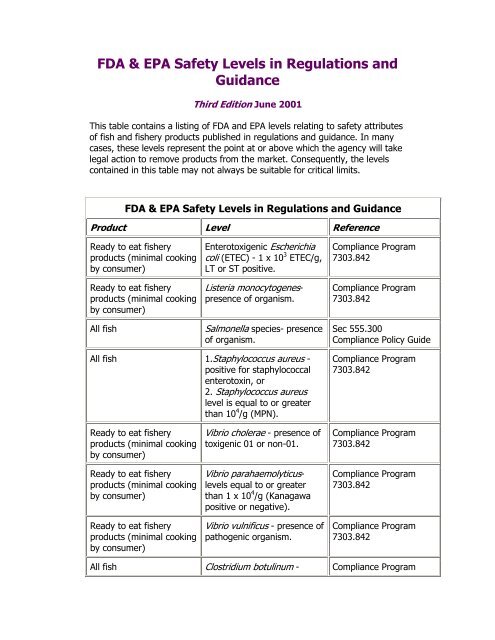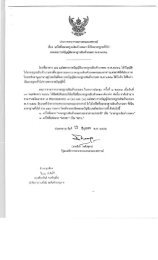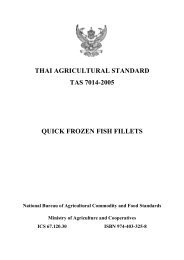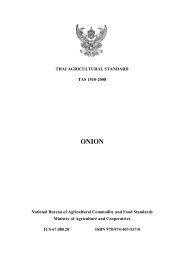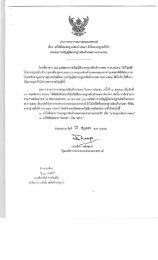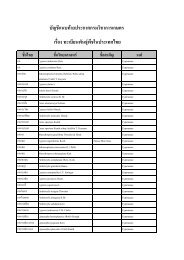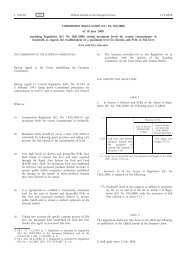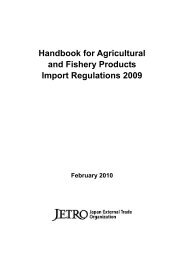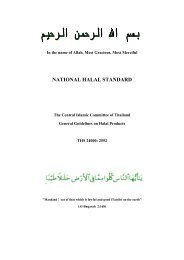FDA & EPA Safety Levels in Regulations and Guidance
FDA & EPA Safety Levels in Regulations and Guidance
FDA & EPA Safety Levels in Regulations and Guidance
Create successful ePaper yourself
Turn your PDF publications into a flip-book with our unique Google optimized e-Paper software.
<strong>FDA</strong> & <strong>EPA</strong> <strong>Safety</strong> <strong>Levels</strong> <strong>in</strong> <strong>Regulations</strong> <strong>and</strong><br />
<strong>Guidance</strong><br />
Third Edition June 2001<br />
This table conta<strong>in</strong>s a list<strong>in</strong>g of <strong>FDA</strong> <strong>and</strong> <strong>EPA</strong> levels relat<strong>in</strong>g to safety attributes<br />
of fish <strong>and</strong> fishery products published <strong>in</strong> regulations <strong>and</strong> guidance. In many<br />
cases, these levels represent the po<strong>in</strong>t at or above which the agency will take<br />
legal action to remove products from the market. Consequently, the levels<br />
conta<strong>in</strong>ed <strong>in</strong> this table may not always be suitable for critical limits.<br />
<strong>FDA</strong> & <strong>EPA</strong> <strong>Safety</strong> <strong>Levels</strong> <strong>in</strong> <strong>Regulations</strong> <strong>and</strong> <strong>Guidance</strong><br />
Product Level Reference<br />
Ready to eat fishery<br />
products (m<strong>in</strong>imal cook<strong>in</strong>g<br />
by consumer)<br />
Ready to eat fishery<br />
products (m<strong>in</strong>imal cook<strong>in</strong>g<br />
by consumer)<br />
All fish<br />
Enterotoxigenic Escherichia<br />
coli (ETEC) - 1 x 10 3 ETEC/g,<br />
LT or ST positive.<br />
Listeria monocytogenespresence<br />
of organism.<br />
Salmonella species- presence<br />
of organism.<br />
Compliance Program<br />
7303.842<br />
Compliance Program<br />
7303.842<br />
Sec 555.300<br />
Compliance Policy Guide<br />
All fish 1.Staphylococcus aureus -<br />
positive for staphylococcal<br />
enterotox<strong>in</strong>, or<br />
2. Staphylococcus aureus<br />
level is equal to or greater<br />
than 10 4 /g (MPN).<br />
Compliance Program<br />
7303.842<br />
Ready to eat fishery<br />
products (m<strong>in</strong>imal cook<strong>in</strong>g<br />
by consumer)<br />
Ready to eat fishery<br />
products (m<strong>in</strong>imal cook<strong>in</strong>g<br />
by consumer)<br />
Ready to eat fishery<br />
products (m<strong>in</strong>imal cook<strong>in</strong>g<br />
by consumer)<br />
Vibrio cholerae - presence of<br />
toxigenic 01 or non-01.<br />
Vibrio parahaemolyticuslevels<br />
equal to or greater<br />
than 1 x 10 4 /g (Kanagawa<br />
positive or negative).<br />
Vibrio vulnificus - presence of<br />
pathogenic organism.<br />
Compliance Program<br />
7303.842<br />
Compliance Program<br />
7303.842<br />
Compliance Program<br />
7303.842<br />
All fish Clostridium botul<strong>in</strong>um - Compliance Program
Clams <strong>and</strong> oysters, fresh<br />
or frozen - imports<br />
Clams, oysters, <strong>and</strong><br />
mussels, fresh or frozen -<br />
domestic<br />
Salt-cured, air-dried<br />
uneviscerated fish<br />
Tuna, mahi mahi, <strong>and</strong><br />
related fish<br />
All fish<br />
F<strong>in</strong> fish <strong>and</strong> shellfish<br />
1. Presence of viable spores<br />
or vegetative cells <strong>in</strong><br />
products that will support<br />
their growth; or,<br />
2. Presence of tox<strong>in</strong>.<br />
Microbiological -<br />
1. E. coli - MPN of 230/100<br />
grams (average of subs or 3<br />
or more of 5 subs);<br />
2. APC - 500,000/gram<br />
(average of subs or 3 or<br />
more of 5 subs).<br />
Microbiological -<br />
1. E. coli or fecal coliform - 1<br />
or more of 5 subs exceed<strong>in</strong>g<br />
MPN of 330/100 grams or 2<br />
or more exceed<strong>in</strong>g 230/100<br />
grams;<br />
2. APC - 1 or more of 5 subs<br />
exceed<strong>in</strong>g 1,500,000/gram or<br />
2 or more exceed<strong>in</strong>g<br />
500,000/gram.<br />
Not permitted <strong>in</strong> commerce<br />
(Note: small fish exemption).<br />
Histam<strong>in</strong>e - 500 ppm based<br />
on toxicity. 50 ppm defect<br />
action level, because<br />
histam<strong>in</strong>e is generally not<br />
uniformly distributed <strong>in</strong> a<br />
decomposed fish. Therefore,<br />
50 ppm is found <strong>in</strong> one<br />
section, there is the<br />
possibility that other units<br />
may exceed 500 ppm.<br />
Polychlor<strong>in</strong>ated Biphenyls<br />
(PCBs) - 2.0 ppm (edible<br />
portion)*.<br />
Aldr<strong>in</strong> <strong>and</strong> dieldr<strong>in</strong> - 0.3 ppm<br />
(edible portion).<br />
7303.842<br />
Sec 560.600<br />
Compliance Policy Guide<br />
Compliance Program<br />
7303.842<br />
Sec 540.650<br />
Compliance Policy Guide<br />
Sec 540.525<br />
Compliance Policy Guide<br />
21 CFR 109.30<br />
Sec 575.100<br />
Compliance Policy Guide<br />
Frog legs Benzene Hexachloride - 0.3<br />
ppm (edible portion).<br />
Sec 575.100<br />
Compliance Policy Guide
All fish<br />
All fish<br />
Chlordane - 0.3 ppm (edible<br />
portion).<br />
Chlordecone - 0.4 ppm<br />
crabmeat <strong>and</strong> 0.3 ppm <strong>in</strong><br />
other fish (edible portion).<br />
Sec 575.100<br />
Compliance Policy Guide<br />
Sec 575.100<br />
Compliance Policy Guide<br />
All fish DDT, TDE <strong>and</strong> DDE - 5.0<br />
ppm (edible portion).<br />
Sec 575.100<br />
Compliance Policy Guide<br />
All fish<br />
All fish<br />
Heptachlor <strong>and</strong> heptachlor<br />
epoxide - 0.3 ppm (edible<br />
portion).<br />
Mirex - 0.1 ppm (edible<br />
portion).<br />
Sec 575.100<br />
Compliance Policy Guide<br />
Sec 575.100<br />
Compliance Policy Guide<br />
All fish Diquat - 0.1 ppm*. 40 CFR 180.226<br />
F<strong>in</strong> fish <strong>and</strong> crayfish Fluridone - 0.5 ppm*. 40 CFR 180.420<br />
F<strong>in</strong> fish Glyphosate - 0.25 ppm*. 40 CFR 180.364<br />
Shellfish Glyphosate - 3.0 ppm*. 40 CFR 180.364<br />
F<strong>in</strong> fish Simaz<strong>in</strong>e - 12 ppm*. 40 CFR 180.213a<br />
All fish 2,4-D - 1.0 ppm*. 40 CFR 180.142<br />
Salmonids, catfish <strong>and</strong><br />
lobster<br />
Oxytetracycl<strong>in</strong>e - 2.0 ppm. 21 CFR 556.500<br />
All fish<br />
Salmonids <strong>and</strong> catfish<br />
All fish<br />
Crustacea<br />
Clams, oysters, <strong>and</strong><br />
mussels<br />
Sulfameraz<strong>in</strong>e - no residue<br />
permitted.<br />
Sulfadimethox<strong>in</strong>e/ormetoprim<br />
comb<strong>in</strong>ation - 0.1 ppm.<br />
Unsanctioned drugs ** - no<br />
residue permitted<br />
Toxic elements: 76 ppm<br />
arsenic; 3 ppm cadmium; 12<br />
ppm chromium; 1.5 ppm<br />
lead; 70 ppm nickel.<br />
Toxic elements: 86 ppm<br />
arsenic; 4 ppm cadmium; 13<br />
ppm chromium; 1.7 ppm<br />
lead; 80 ppm nickel.<br />
21 CFR 556.660<br />
21 CFR 556.640<br />
Sec 615.200<br />
Compliance Policy Guide<br />
<strong>FDA</strong> <strong>Guidance</strong><br />
Documents<br />
<strong>FDA</strong> <strong>Guidance</strong><br />
Documents
All fish Methyl mercury - 1.0 ppm *** Sec 540.600<br />
Compliance Policy Guide<br />
All fish Paralytic shellfish poison -<br />
0.8 ppm (80 g/100g)<br />
saxitox<strong>in</strong> equivalent.<br />
Sec 540.250<br />
Compliance Policy Guide,<br />
<strong>and</strong><br />
Compliance Program<br />
7303.842<br />
Clams, mussels <strong>and</strong><br />
oysters, fresh, frozen or<br />
canned<br />
Neurotoxic shellfish poison -<br />
0.8 ppm (20 mouse<br />
units/100 gram) brevetox<strong>in</strong>-2<br />
equivalent.<br />
National Shellfish<br />
Sanitation Program<br />
Manual of Operations<br />
All fish Amnesic shellfish poison - 20<br />
ppm domoic acid, except <strong>in</strong><br />
the viscera of dungeness<br />
crab, where 30 ppm is<br />
permitted.<br />
Compliance Program<br />
7303.842<br />
All fish<br />
Hard or sharp foreign object<br />
- generally 0.3 (7mm) to 1.0<br />
(25mm) <strong>in</strong> length<br />
Sec 555.425 Compliance<br />
Policy Guide<br />
* These values are tolerances.<br />
** Sanctioned drugs are approved drugs <strong>and</strong> drugs used under an INAD. For<br />
additional <strong>in</strong>formation.<br />
Unregulated/unapproved drugs adm<strong>in</strong>istered to aquacultured fish pose a<br />
potential human health hazard. These substances may be carc<strong>in</strong>ogenic, allergenic,<br />
<strong>and</strong>/or may cause antibiotic resistance <strong>in</strong> man. To control this hazard <strong>in</strong> food animals,<br />
all drugs, whether for direct medication or for addition to feed, must be approved by<br />
<strong>FDA</strong>. Under certa<strong>in</strong> conditions authorized by <strong>FDA</strong>, unapproved new animal drugs may<br />
be used <strong>in</strong> conformance with the terms of an Investigational New Animal Drug<br />
(INAD) application.<br />
Incentives for the use of animal drugs <strong>in</strong> aquatic animal species <strong>in</strong>clude the need to:<br />
1) treat <strong>and</strong> prevent disease; 2) control parasites; 3) affect reproduction <strong>and</strong> growth;<br />
<strong>and</strong>, 4) tranquilization (e.g. dur<strong>in</strong>g transit). Relatively few drugs have been approved<br />
for aquaculture. As a result, aquaculture growers may use unapproved drugs, general<br />
purpose chemicals that are not labeled for drug use, <strong>and</strong> approved drugs <strong>in</strong> a<br />
manner that deviates from the labeled <strong>in</strong>structions.<br />
When a drug is approved by <strong>FDA</strong>'s Center for Veter<strong>in</strong>ary Medic<strong>in</strong>e, the conditions of<br />
the approval are listed on its label. These conditions <strong>in</strong>clude: the species for which<br />
the drug is approved; the approved dosage; the approved route of adm<strong>in</strong>istration;<br />
the approved frequency of use; <strong>and</strong> the approved <strong>in</strong>dications for use. Only a licensed
veter<strong>in</strong>arian may legally prescribe or use a drug under conditions that are not listed<br />
on the label. This restriction is more fully expla<strong>in</strong>ed <strong>in</strong> 21 CFR 530.<br />
Labels of approved drugs list m<strong>and</strong>atory withdrawal times, where applicable. These<br />
withdrawal times must be observed to ensure that the edible tissue is safe when it is<br />
offered for sale. Tissue residue tolerances have been established for some drugs.<br />
*** For additional <strong>in</strong>formation.<br />
The draft Fish <strong>and</strong> Fishery Products Hazards <strong>and</strong> Controls Guide (February 16,<br />
1994) listed methyl mercury as a potential safety hazard for bonito, halibut, Spanish<br />
mackerel, k<strong>in</strong>g mackerel, marl<strong>in</strong>, shark, swordfish, <strong>and</strong> bluef<strong>in</strong> tuna. The selection of<br />
these species was based on historical data on levels of methyl mercury found <strong>in</strong> fish<br />
consumed <strong>in</strong> the U.S. The selection was also based on an <strong>FDA</strong> action level of 1.0<br />
ppm <strong>in</strong> the edible portion of fish.<br />
While <strong>FDA</strong> has not changed the 1.0 ppm action level, the agency is re-evaluat<strong>in</strong>g it <strong>in</strong><br />
light of significant new data on the health effects of methyl mercury from<br />
consumption of fish. These data have become available s<strong>in</strong>ce the action level was<br />
developed.<br />
When the action level re-evaluation is completed, <strong>FDA</strong> will, among other th<strong>in</strong>gs,<br />
update this Guide by <strong>in</strong>clud<strong>in</strong>g advice on how to assess the significance of a potential<br />
methyl mercury hazard <strong>in</strong> fish, <strong>and</strong> what controls, if any, are necessary to ensure the<br />
safety of fish <strong>in</strong> this regard.<br />
The Food <strong>and</strong> Drug Adm<strong>in</strong>istration (<strong>FDA</strong>) <strong>and</strong> the Environmental Protection<br />
Agency (<strong>EPA</strong>) announced on March 19 2004 their jo<strong>in</strong>t consumer advisory on<br />
methylmercury <strong>in</strong> fish <strong>and</strong> shellfish for reduc<strong>in</strong>g the exposure to high levels of<br />
mercury <strong>in</strong> women who may become pregnant, pregnant women, nurs<strong>in</strong>g mothers,<br />
<strong>and</strong> young children. This unifies advice from both <strong>FDA</strong> <strong>and</strong> <strong>EPA</strong> <strong>and</strong> supersedes <strong>FDA</strong>'s<br />
<strong>and</strong> <strong>EPA</strong>'s 2001 advisories.<br />
The <strong>FDA</strong> <strong>and</strong> <strong>EPA</strong> want to emphasize the benefits of eat<strong>in</strong>g fish - consumers should<br />
know that fish <strong>and</strong> shellfish can be important parts of a healthy <strong>and</strong> balanced diet.<br />
They are good sources of high quality prote<strong>in</strong> <strong>and</strong> other essential nutrients; however,<br />
as a matter of prudence, women might wish to modify the amount <strong>and</strong> type of fish<br />
they consume if they are plann<strong>in</strong>g to become pregnant, pregnant, nurs<strong>in</strong>g, or feed<strong>in</strong>g<br />
a young child. By follow<strong>in</strong>g these three recommendations for select<strong>in</strong>g <strong>and</strong> eat<strong>in</strong>g fish<br />
or shellfish, women will receive the benefits of eat<strong>in</strong>g fish <strong>and</strong> shellfish <strong>and</strong> be<br />
confident that they have reduced their exposure to the harmful effects of mercury.<br />
1. Do not eat Shark, Swordfish, K<strong>in</strong>g Mackerel, or Tilefish because they conta<strong>in</strong> high<br />
levels of mercury.<br />
2. Eat up to 12 ounces (two average meals) a week of a variety of fish <strong>and</strong> shellfish<br />
that are lower <strong>in</strong> mercury.
• Five of the most commonly eaten fish that are low <strong>in</strong> mercury are shrimp,<br />
canned light tuna, salmon,pollock, <strong>and</strong> catfish.<br />
• Another commonly eaten fish, albacore ("white") tuna has more mercury than<br />
canned light tuna. So, when choos<strong>in</strong>g your two meals of fish <strong>and</strong> shellfish, you<br />
may eat up to six ounces (one average meal) of albacore tuna per week.<br />
3. Check local advisories about the safety of fish caught by family <strong>and</strong> friends <strong>in</strong> your<br />
local lakes, rivers <strong>and</strong> coastal areas. If no advice is available, eat up to six ounces<br />
(one average meal) per week of fish you catch from local waters, but don't consume<br />
any other fish dur<strong>in</strong>g that week.<br />
Follow these same recommendations when feed<strong>in</strong>g fish <strong>and</strong> shellfish to your young<br />
child, but serve smaller portions.<br />
"This revised advisory is a culm<strong>in</strong>ation of months of hard work by both agencies,"<br />
said <strong>FDA</strong> Deputy Commissioner Lester M. Crawford, D.V.M., Ph.D. "By follow<strong>in</strong>g this<br />
advice, we're confident that women <strong>and</strong> young children can safely <strong>in</strong>clude fish as an<br />
important part of a healthy diet."<br />
In July 2002, <strong>FDA</strong>'s Food Advisory Committee met <strong>and</strong> made several<br />
recommendations to <strong>FDA</strong> on how to revise its 2001 consumer advisory on<br />
methylmercury <strong>in</strong> fish with special concern for pregnant women, nurs<strong>in</strong>g mothers,<br />
women who may become pregnant, <strong>and</strong> young children. One recommendation was<br />
for <strong>FDA</strong> <strong>and</strong> <strong>EPA</strong> to coord<strong>in</strong>ate mercury advisories on commercial fish <strong>and</strong><br />
recreational fish <strong>and</strong> say someth<strong>in</strong>g specific about canned tuna.<br />
In December 2003, <strong>FDA</strong>'s Food Advisory Committee met aga<strong>in</strong> to be updated on the<br />
progress <strong>FDA</strong> had made <strong>in</strong> respond<strong>in</strong>g to their recommendations. At that time the<br />
committee recommended list<strong>in</strong>g <strong>in</strong> the advisory fish that are low <strong>in</strong> mercury. S<strong>in</strong>ce<br />
the December 2003 meet<strong>in</strong>g <strong>and</strong> the period of time between the two meet<strong>in</strong>gs, <strong>FDA</strong><br />
<strong>and</strong> <strong>EPA</strong> have been work<strong>in</strong>g together toward the goal of provid<strong>in</strong>g an updated<br />
consumer advisory <strong>in</strong> response to the recommendations from the Food Advisory<br />
Committee. This work has <strong>in</strong>cluded conduct<strong>in</strong>g ongo<strong>in</strong>g <strong>in</strong>teragency meet<strong>in</strong>gs,<br />
conduct<strong>in</strong>g field assignments which provided additional test<strong>in</strong>g of mercury <strong>in</strong> fish for<br />
which there were low sample sizes, sampl<strong>in</strong>g over 3400 cans of tuna, undertak<strong>in</strong>g<br />
exposure assessments us<strong>in</strong>g these new data <strong>and</strong> conduct<strong>in</strong>g focus group test<strong>in</strong>g on<br />
the revised advisory.<br />
"Our guidance allows consumers to make educated dietary choices for fish they catch<br />
or buy," said <strong>EPA</strong>'s Act<strong>in</strong>g Assistant Adm<strong>in</strong>istrator for the Office of Water Benjam<strong>in</strong><br />
Grumbles. "With a few simple adjustments, consumers can cont<strong>in</strong>ue to enjoy these<br />
foods <strong>in</strong> a manner that is healthy <strong>and</strong> beneficial."<br />
As part of announc<strong>in</strong>g the revised consumer advisory, <strong>FDA</strong> <strong>and</strong> <strong>EPA</strong> plan to launch a<br />
comprehensive outreach <strong>and</strong> educational campaign. Additional <strong>in</strong>formation can be<br />
found at: www.cfsan.fda.gov or the <strong>EPA</strong> website at www.epa.gov/ost/fish.
Mercury <strong>Levels</strong> <strong>in</strong> Commercial Fish <strong>and</strong> Shellfish<br />
SPECIES<br />
Table 1. Fish <strong>and</strong> Shellfish With Highest <strong>Levels</strong> of Mercury<br />
MERCURY CONCENTRATION (PPM)<br />
MEAN MEDIAN STDEV MIN MAX<br />
NO. OF<br />
SAMPLES<br />
SOURCE OF<br />
DATA<br />
MACKEREL KING 0.730 N/A N/A 0.230 1.670 213<br />
GULF OF<br />
MEXICO<br />
REPORT 2000<br />
SHARK 0.988 0.830 0.631 ND 4.540 351 <strong>FDA</strong> 1990-02<br />
SWORDFISH 0.976 0.860 0.510 ND 3.220 618 <strong>FDA</strong> 1990-04<br />
TILEFISH (Gulf<br />
of Mexico)<br />
1.450 N/A N/A 0.650 3.730 60<br />
NMFS REPORT<br />
1978<br />
SPECIES<br />
Table 2. Fish <strong>and</strong> Shellfish With Lower <strong>Levels</strong> of Mercury †<br />
MERCURY CONCENTRATION (PPM)<br />
MEAN MEDIAN STDEV MIN MAX<br />
NO. OF<br />
SAMPLES<br />
ANCHOVIES 0.043 N/A N/A ND 0.340 40<br />
SOURCE OF<br />
DATA<br />
NMFS REPORT<br />
1978<br />
BUTTERFISH 0.058 N/A N/A ND 0.360 89<br />
NMFS REPORT<br />
1978<br />
CATFISH 0.049 ND 0.084 ND 0.314 23 <strong>FDA</strong> 1990-04<br />
CLAM * ND ND ND ND ND 6 <strong>FDA</strong> 1990-02<br />
COD 0.095 0.087 0.080 ND 0.420 39 <strong>FDA</strong> 1990-04<br />
CRAB 1 0.060 0.030 0.112 ND 0.610 63 <strong>FDA</strong> 1990-04<br />
CRAWFISH 0.033 0.035 0.012 ND 0.051 44 <strong>FDA</strong> 2002-04<br />
CROAKER ATLANTIC<br />
0.072 0.073 0.036 0.013 0.148 35 <strong>FDA</strong> 1990-03<br />
(Atlantic)<br />
FLATFISH 2 * 0.045 0.035 0.049 ND 0.180 23 <strong>FDA</strong> 1990-04<br />
HADDOCK (Atlantic) 0.031 0.041 0.021 ND 0.041 4 <strong>FDA</strong> 1990-02<br />
HAKE 0.014 ND 0.021 ND 0.048 9 <strong>FDA</strong> 1990-02<br />
HERRING 0.044 N/A N/A ND 0.135 38<br />
NMFS REPORT<br />
1978<br />
JACKSMELT 0.108 0.060 0.115 0.040 0.500 16 <strong>FDA</strong> 1990-02<br />
<strong>FDA</strong> SURVEY<br />
LOBSTER (Sp<strong>in</strong>y) 0.09 0.14 ‡ ND 0.27 9<br />
1990-02<br />
MACKEREL<br />
ATLANTIC<br />
(N.Atlantic)<br />
MACKEREL CHUB<br />
(Pacific)<br />
0.050 N/A N/A 0.020 0.160 80<br />
0.088 N/A N/A 0.030 0.190 30<br />
MULLET 0.046 N/A N/A ND 0.130 191<br />
NMFS REPORT<br />
1978<br />
NMFS REPORT<br />
1978<br />
NMFS REPORT<br />
1978<br />
OYSTER 0.013 ND 0.042 ND 0.250 38 <strong>FDA</strong> 1990-04<br />
PERCH OCEAN * ND ND ND ND 0.030 6 <strong>FDA</strong> 1990-02
POLLOCK 0.041 ND 0.106 ND 0.780 62 <strong>FDA</strong> 1990-04<br />
SALMON (CANNED)<br />
*<br />
ND ND ND ND ND 23 <strong>FDA</strong> 1990-02<br />
SALMON<br />
0.014 ND 0.041 ND 0.190 34 <strong>FDA</strong> 1990-02<br />
(FRESH/FROZEN) *<br />
SARDINE 0.016 0.013 0.007 0.004 0.035 29 <strong>FDA</strong> 2002-04<br />
SCALLOP 0.050 N/A N/A ND 0.220 66<br />
NMFS REPORT<br />
1978<br />
SHAD AMERICAN 0.065 N/A N/A ND 0.220 59<br />
NMFS REPORT<br />
1978<br />
SHRIMP * ND ND ND ND 0.050 24 <strong>FDA</strong> 1990-02<br />
SQUID 0.070 N/A N/A ND 0.400 200<br />
NMFS REPORT<br />
1978<br />
TILAPIA * 0.010 ND 0.023 ND 0.070 9 <strong>FDA</strong> 1990-02<br />
TROUT<br />
(FRESHWATER)<br />
0.072 0.025 0.143 ND 0.678 34 <strong>FDA</strong> 2002-04<br />
TUNA (CANNED,<br />
LIGHT)<br />
0.118 0.075 0.119 ND 0.852 347 <strong>FDA</strong> 2002-04<br />
WHITEFISH 0.069 0.054 0.067 ND 0.310 28 <strong>FDA</strong> 2002-04<br />
WHITING ND ND ‡ ND ND 2<br />
<strong>FDA</strong> SURVEY<br />
1990-02<br />
SPECIES<br />
Table 3. Mercury <strong>Levels</strong> of Other Fish <strong>and</strong> Shellfish †<br />
MERCURY CONCENTRATION (PPM) NO. OF<br />
MEAN MEDIAN STDEV MIN MAX SAMPLES<br />
SOURCE OF<br />
DATA<br />
BASS (SALTWATER, BLACK,<br />
STRIPED) 3 0.219 0.130 0.227 ND 0.960 47 <strong>FDA</strong> 1990-04<br />
BASS CHILEAN 0.386 0.303 0.364 0.085 2.180 40 <strong>FDA</strong> 1990-04<br />
BLUEFISH 0.337 0.303 0.127 0.139 0.634 52 <strong>FDA</strong> 2002-04<br />
BUFFALOFISH 0.19 0.14 ‡ 0.05 0.43 4<br />
<strong>FDA</strong> SURVEY<br />
1990-02<br />
<strong>FDA</strong> SURVEY<br />
CARP 0.14 0.14 ‡ 0.01 0.27 2<br />
1990-02<br />
CROAKER WHITE (Pacific) 0.287 0.280 0.069 0.180 0.410 15 <strong>FDA</strong> 1990-03<br />
GROUPER (ALL SPECIES) 0.465 0.410 0.293 0.053 1.205 43 <strong>FDA</strong> 2002-04<br />
HALIBUT 0.252 0.200 0.233 ND 1.520 46 <strong>FDA</strong> 1990-04<br />
LOBSTER<br />
(NORTHERN/AMERICAN)<br />
0.310 N/A N/A 0.050 1.310 88<br />
NMFS REPORT<br />
1978<br />
LOBSTER (Species Unknown) 0.169 0.182 0.089 ND 0.309 16 <strong>FDA</strong> 1991-2004<br />
MACKEREL SPANISH (Gulf of<br />
Mexico)<br />
MACKEREL SPANISH (S.<br />
Atlantic)<br />
0.454 N/A N/A 0.070 1.560 66<br />
0.182 N/A N/A 0.050 0.730 43<br />
NMFS REPORT<br />
1978<br />
NMFS REPORT<br />
1978<br />
MARLIN * 0.485 0.390 0.237 0.100 0.920 16 <strong>FDA</strong> 1990-02<br />
MONKFISH 0.180 N/A N/A 0.020 1.020 81<br />
NMFS REPORT<br />
1978<br />
ORANGE ROUGHY 0.554 0.563 0.148 0.296 0.855 49 <strong>FDA</strong> 1990-04<br />
PERCH (Freshwater) 0.14 0.15 ‡ ND 0.31 5 <strong>FDA</strong> SURVEY
SABLEFISH 0.220 N/A N/A ND 0.700 102<br />
SCORPIONFISH 0.286 N/A N/A 0.020 1.345 78<br />
SHEEPSHEAD 0.128 N/A N/A 0.020 0.625 59<br />
1990-02<br />
NMFS REPORT<br />
1978<br />
NMFS REPORT<br />
1978<br />
NMFS REPORT<br />
1978<br />
NMFS REPORT<br />
SKATE 0.137 N/A N/A 0.040 0.360 56<br />
1978<br />
SNAPPER 0.189 0.114 0.274 ND 1.366 43 <strong>FDA</strong> 2002-04<br />
TILEFISH (Atlantic) 0.144 0.099 0.122 0.042 0.533 32 <strong>FDA</strong> 2002-04<br />
TUNA (CANNED, ALBACORE) 0.353 0.339 0.126 ND 0.853 399 <strong>FDA</strong> 2002-04<br />
TUNA(FRESH/FROZEN, ALL) 0.383 0.322 0.269 ND 1.300 228 <strong>FDA</strong> 2002-04<br />
TUNA (FRESH/FROZEN,<br />
ALBACORE)<br />
TUNA (FRESH/FROZEN,<br />
BIGEYE)<br />
TUNA (FRESH/FROZEN,<br />
SKIPJACK)<br />
TUNA (FRESH/FROZEN,<br />
YELLOWFIN)<br />
0.357 0.355 0.152 ND 0.820 26 <strong>FDA</strong> 2002-04<br />
0.639 0.560 0.184 0.410 1.040 13 <strong>FDA</strong> 2002-04<br />
0.205 N/A 0.078 0.205 0.260 2 <strong>FDA</strong> 1993<br />
0.325 0.270 0.220 ND 1.079 87 <strong>FDA</strong> 2002-04<br />
TUNA (FRESH/FROZEN,<br />
Species Unknown)<br />
0.414 0.339 0.316 ND 1.300 100 <strong>FDA</strong> 1991-2004<br />
WEAKFISH (SEA TROUT) 0.256 0.168 0.226 ND 0.744 39 <strong>FDA</strong> 2002-04<br />
Source of data: <strong>FDA</strong> 1990-2004, "National Mar<strong>in</strong>e Fisheries Service Survey of Trace<br />
Elements <strong>in</strong> the Fishery Resource" Report 1978,<br />
"The Occurrence of Mercury <strong>in</strong> the Fishery Resources of the Gulf of Mexico" Report<br />
2000<br />
Mercury was measured as Total Mercury except for species (*) when only<br />
Methylmercury was analyzed.<br />
Note: the term "fish" refers to fresh or saltwater f<strong>in</strong> fish, crustaceans, other forms of<br />
aquatic animal life other than birds or mammals, <strong>and</strong> all mollusks, as def<strong>in</strong>ed <strong>in</strong> 21<br />
CFR 123.3(d).


